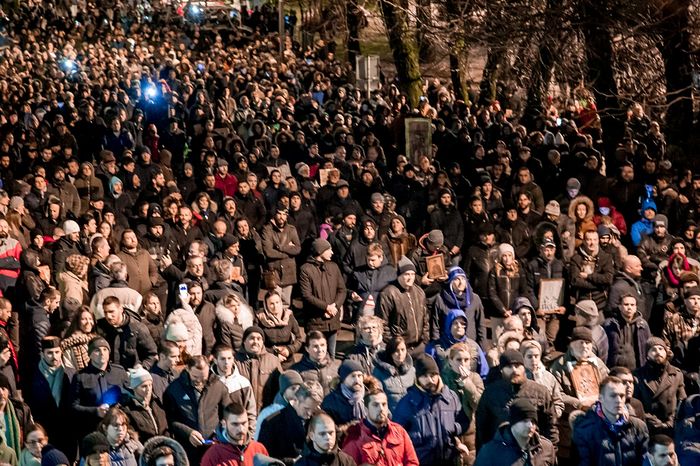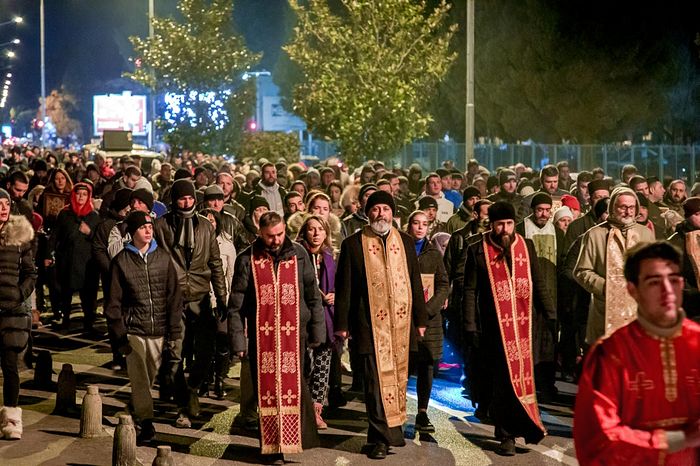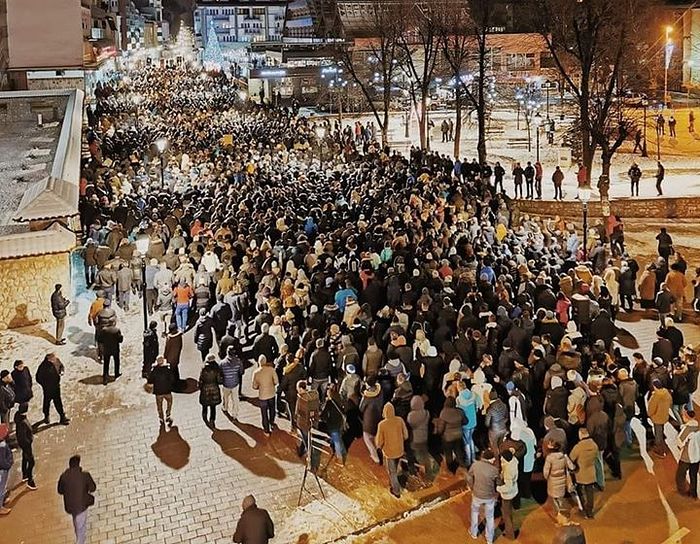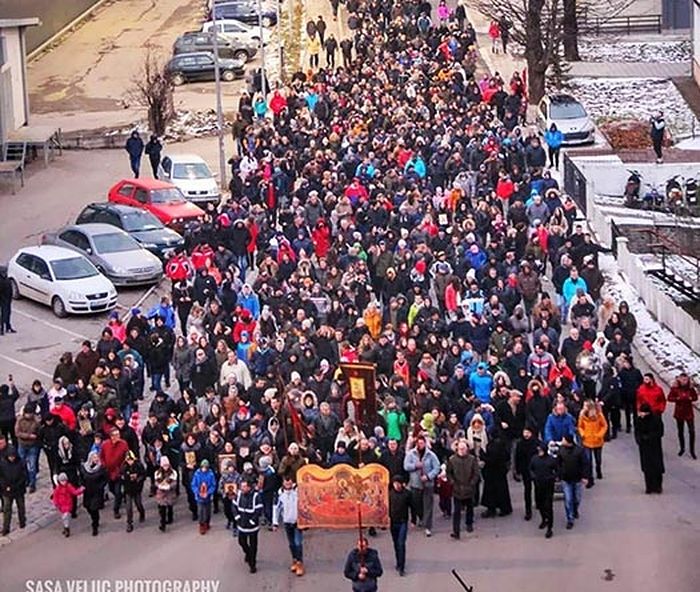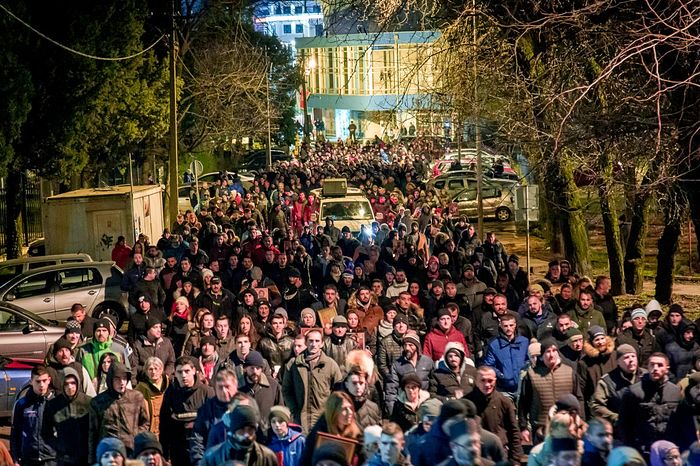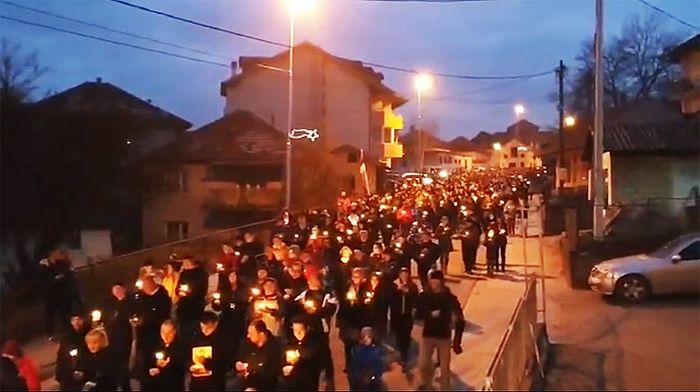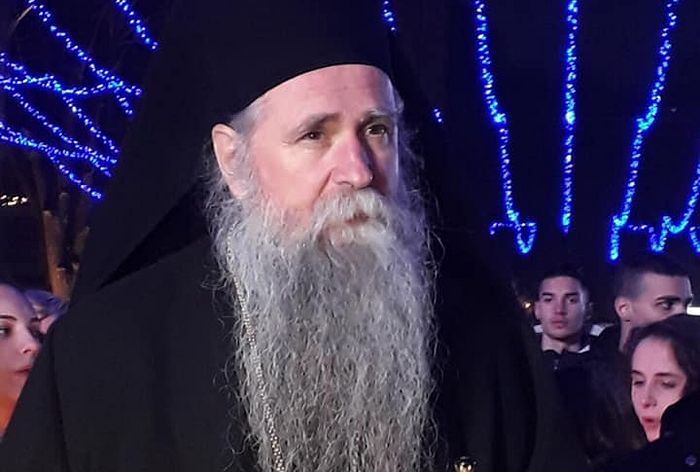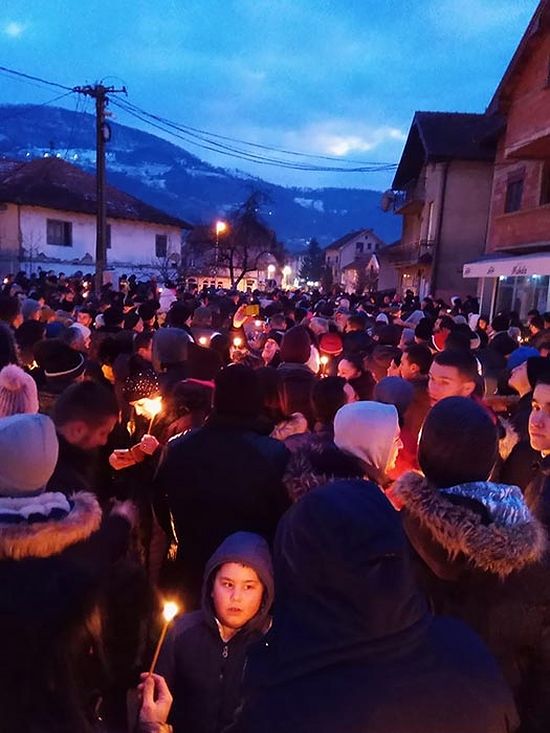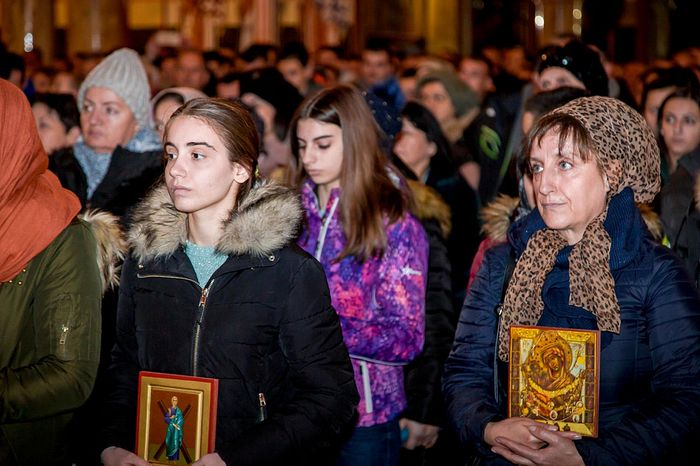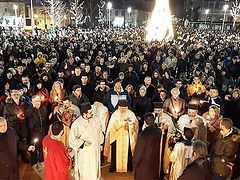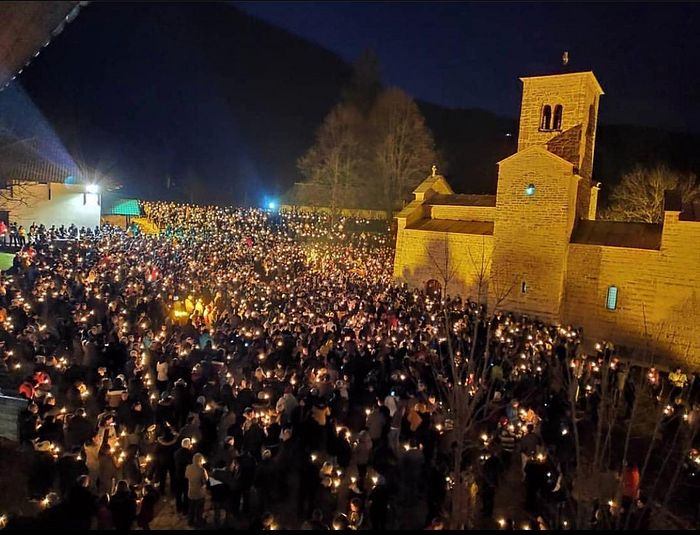 Berane. People praying near St. George’s Monastery.
Berane. People praying near St. George’s Monastery.
The Orthodox faithful in Montenegro are greeting the New Year 2020 in on the streets of their cities. All over the country they are holding prayer services, cross processions and peaceful meetings at which people are praying and protesting against the new discriminatory Church Property Law, passed the day before by the Montenegrin Parliament and signed by President Milo Dukanovic. The law’s most controversial parts are paragraphs 62 and 63, according to which many properties of the Serbian Orthodox Church are to pass into State ownership.
Prayer meetings and rallies took place virtually across the country. The biggest were in the capital city of Podgorica, Niksic, Pljevlja, Berane, Bijelo Polje, Budva, Herceg-Novi, Kotor, Bar and Zabljak. The faithful of all ages are taking to the streets.
In Podgorica the center of the meetings is the Church of the Resurrection of Christ, which holds daily prayer services that grow into processions. It was here that a serious incident took place on December 30. The tension that was sparked between the police and the dispersing protesters (mainly young prayer service participants) resulted in the police using tear gas in the square in front of the church. According to media reports, undercover police among the protesters detained suspicious citizens. Five of the detainees are aged between sixteen and twenty-one. Two minors have already been released, while the others are to appear before the court.
On the basis of the information that there may be provocateurs among the protesters, Church representatives have demanded control over the actions of the bodies dealing with internal affairs. Denouncing the use of force, representatives of the Metropolia of Montenegro and the Littoral called on the Council for the Civil Control of the Police Administration and NGOs to demand internal control of police actions in connection with their acts against prayer service participants. Very strong tension between the protesters and the police was also seen in Niksic and elsewhere, but serious incidents have been avoided so far.
The State authorities are displaying obvious discontent with what is going on. Having passed the law, Dukanovic quickly left for the USA to relax, where he was seen during official entertainment events in Miami. In his absence the mouthpiece of the State in this matter is Prime Minister Dusko Markovic who has already urged the clergy of the Serbian Church to return to their churches and not to urge believers to resist the authorities. According to him, there are no reasons for such “hysteria and manipulations.” Markovic has also stressed that discontented people are taking to the streets after they leave churches, services and “their Liturgies”, and “are attacking the police, citizens and property.”
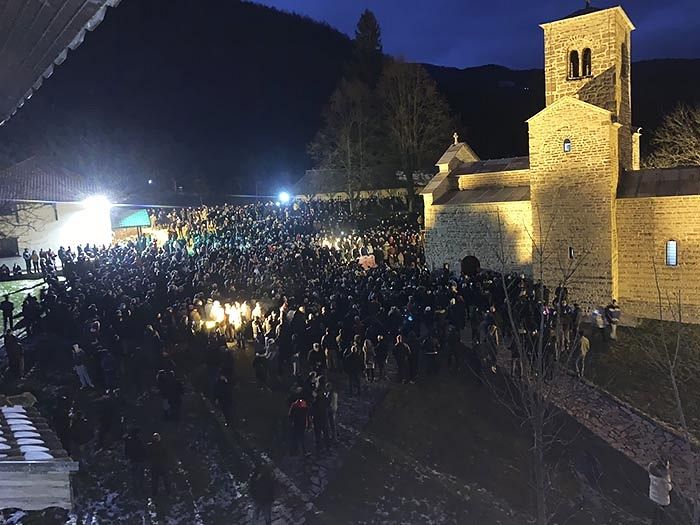 Berane. A prayer service by St. George’s Monastery.
Berane. A prayer service by St. George’s Monastery.
Markovic has urged Church representatives not to incite discontent and disorder, saying that “this is the last warning in this regard”, and that “Montenegro and the State institutions will not allow rioting.” The Montenegrin media periodically accuse the Church of inciting riots as well.
However, prayer services and meetings are held daily. Thus, on January 1, around 10,000 people took part in the prayer service and procession in the town of Bijelo Polje.
Addressing those gathered, Bishop Joanikije of Budimlja and Niksic said, “The passing of such an ugly law means the humiliation of Montenegro and its entire system. What is particularly ominous about it is that it creates a division between brothers which causes inequality between faiths in Montenegro, because all the other religions have already secured all guarantees to ownership of their religious and property and freedoms from our authorities through legal agreements.”
According to His Eminence, it is not a matter of law, but of an act of discrimination and ill will. All who express their disagreement with the present injustice are witnessing their faith, fidelity to the Church and to their holy sites.
“Expressing our disagreement in this way and determination to struggle to the end for the holy sites dedicated to God by our ancestors, we turn to God and the Church in prayer in order to prevent it from being carried out. Brothers and sisters, we cannot stand by in tolerance as the precepts of our ancestors, our fathers and forefathers who lived for the faith and laid down their lives for the preservation of faith and for their honor and dignity are being trampled underfoot. May God strengthen our meeting, which is a great witness to and foundation of the Church of God in faith, love, and hope, so that we can struggle to the end—to our victory!” Bishop Joanikije emphasized.
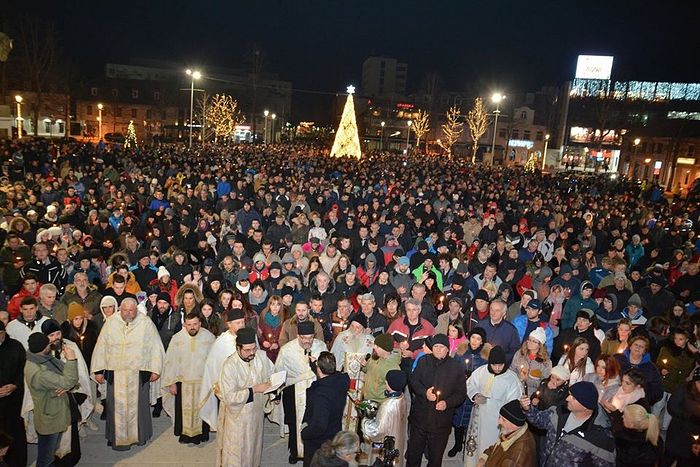 A peaceful protest and prayer service in Niksic.
A peaceful protest and prayer service in Niksic.
Support in the region
Serbs from the whole region are expressing their support of the Church and their Orthodox brothers in Montenegro. First of all, in the neighboring Republika Srpska. Prayer services and processions have been held in Herzegovina, which borders Montenegro: in Trebinje, Gacko, Bileca, Foca, and Visegrad. Similar events took place in Banja Luka.
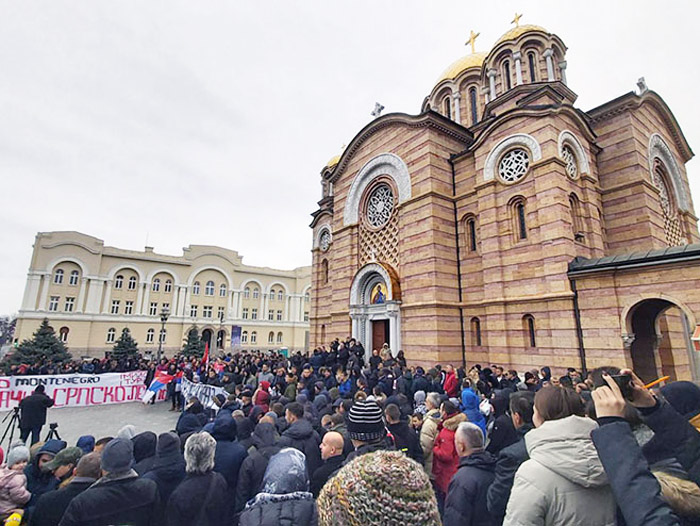 Banja Luka. A meeting in support of the Serbian Church in Montenegro.
Banja Luka. A meeting in support of the Serbian Church in Montenegro.
Demonstrations and rallies outside the Montenegrin Embassy in Belgrad have continued almost non-stop for the past few days. In Novi Sad, Bishop Irinej of Backa headed a cross procession. Prayer services and meetings are taking place all over Serbia. The ruling hierarchs of many dioceses give their blessing for the celebration of daily prayer services to support the suffering Church and the faithful in Montenegro.
“An Appeal in Support of the Serbian Orthodox Church in Montenegro” is circulating on the internet. It has already been signed by thousands of prominent public and cultural figures, writers, journalists, and scientists.
Remarkably, many Serbian public figures pointed to the fact that Serbia’s federal television has given too little coverage of what is going on in Montenegro, often ignoring these events so tragic for Serbs. Nevertheless, on December 31, the Serbian President Aleksandar Vucic met with Patriarch Irinej of Serbia and discussed the current situation in Montenegro with him. Speaking after the meeting before the journalists, His Holiness stressed that what is going on in Montenegro may have serious consequences for the whole region. When asked what should be done in case the Montenegrin authorities begin to take away Church property, the primate expressed his hope that this would not happen and that the authorities would think about this deeply, because they see the reaction of the people. “The people are ready to defend their historical shrines”, he said. “And I believe that it will not happen. And if it does happen, I can only guest at the serious consequences it may have. I am praying to God that reason will overcome the problems.”
Pending the Nativity
Prayer meetings, protests and other public actions in Montenegro will continue and may reach their climax before the Nativity, especially on Christmas Eve,1 the so-called “Badnji Dan”, when believers by tradition gather to burn down “badnjak” [a tree branch or a young tree used in popular ceremonies on this feast.—Trans.] near churches and monasteries.
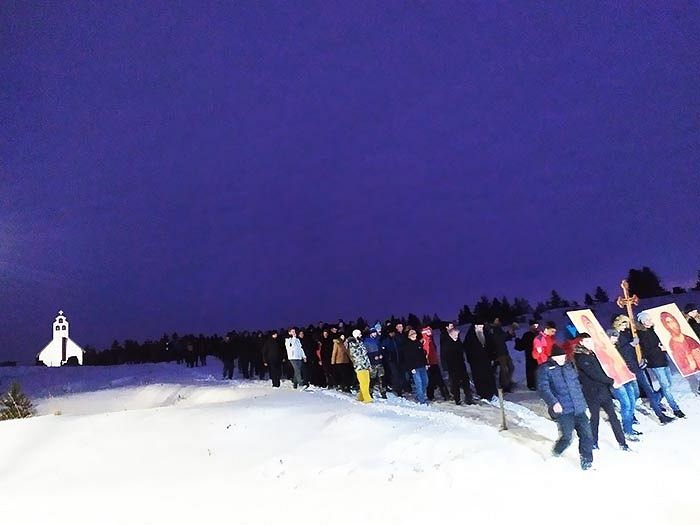 A cross procession at Zabljak. December 31.
A cross procession at Zabljak. December 31.
Most large scale demonstrations are being held in the streets and are of special public importance in many places. For a long time now, this custom in Montenegro has been an indicator of people’s affiliation with either the canonical Church or schismatic circles. Thus, two “badnjaks” have been held for over ten years in Cetinje and elsewhere—one by the canonical Church and the other by the schismatic, so-called “Montenegrin Orthodox Church.” The latter are endorsed by the authorities ever more actively and are often accompanied by political appearances.
It is during the Christmas season that the probability of provocations from the authorities and schismatics is extremely high. There have already been calls in social media to demonstrate the unity of the Montenegrin nation and put an end to Serbian dominion on January 6.
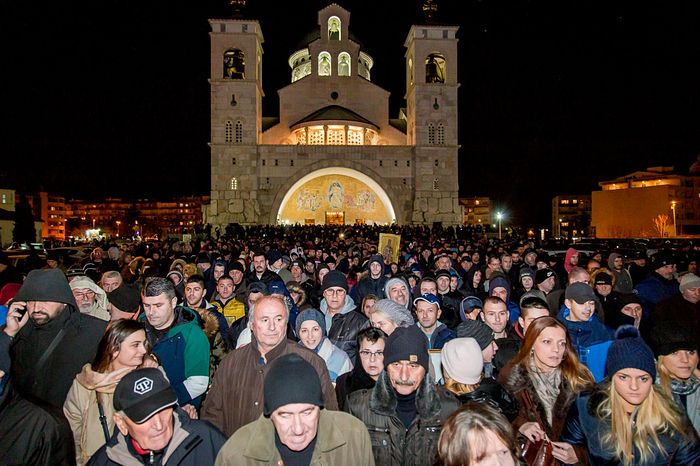 Podgorica. Near the Church of the Resurrection of Christ.
Podgorica. Near the Church of the Resurrection of Christ.
The Serbian clergy call on their flock to remain calm and peaceful, but they nonetheless confirm their willingness to defend their holy places to the end.

